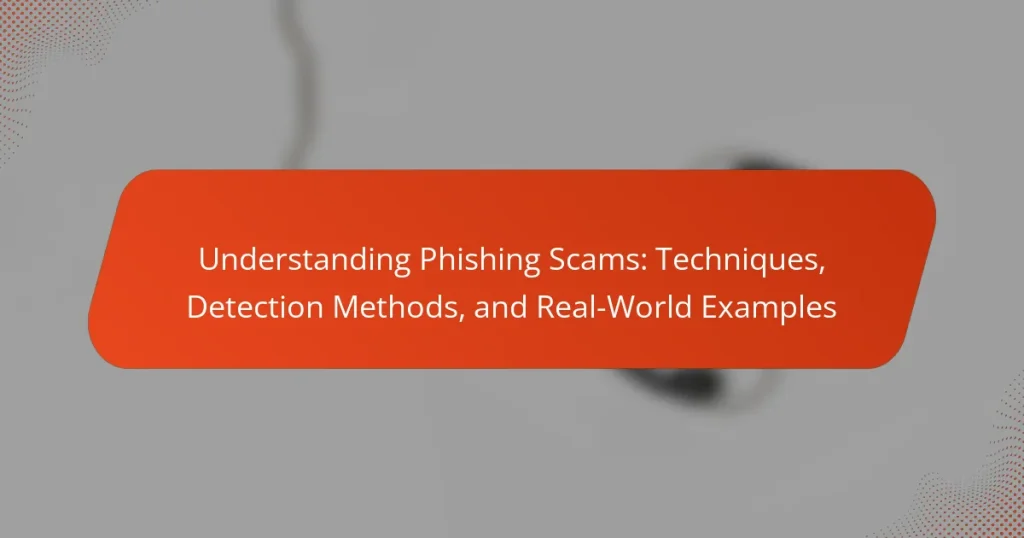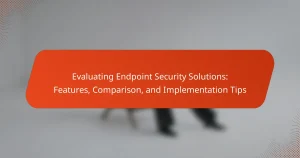Phishing scams are fraudulent attempts designed to obtain sensitive information from individuals through deceptive communications. This article examines various types of phishing scams, including email phishing, spear phishing, whaling, vishing, smishing, clone phishing, and angler phishing, each employing different tactics to deceive victims. It also outlines detection methods to identify potential phishing attempts, such as recognizing generic greetings, checking for spelling errors, and verifying sender addresses. Additionally, the article highlights real-world examples of phishing incidents, emphasizing the financial and identity theft risks associated with these scams. Understanding these aspects is crucial for effective prevention and awareness.
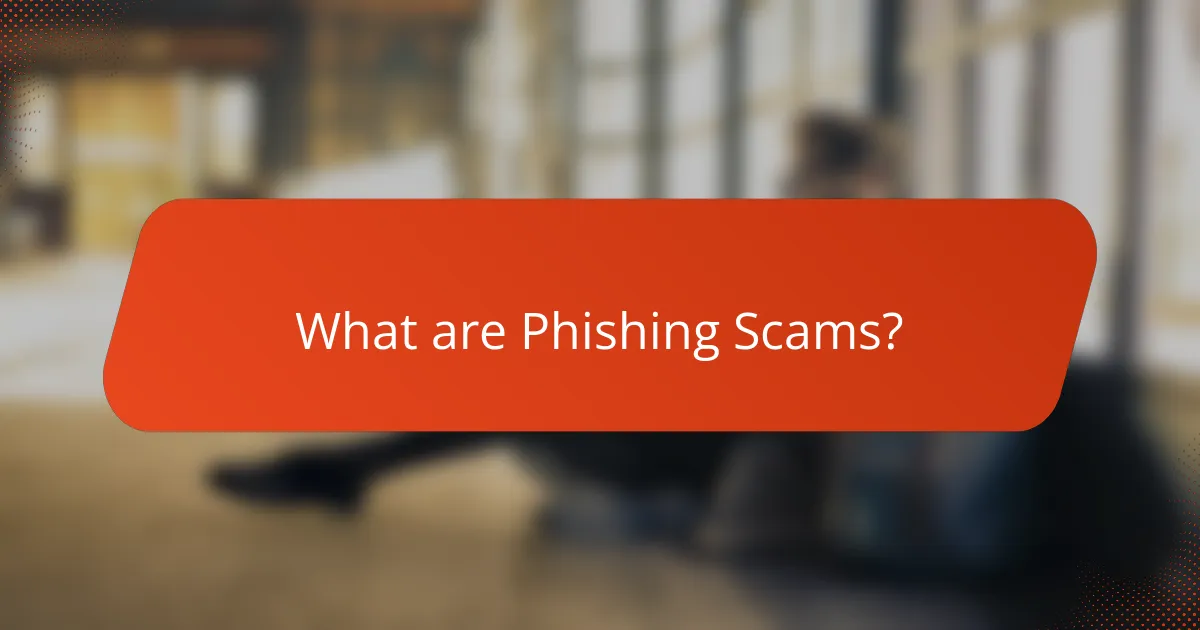
What are Phishing Scams?
Phishing scams are fraudulent attempts to obtain sensitive information from individuals. These scams often occur through deceptive emails, messages, or websites that appear legitimate. Cybercriminals impersonate trusted entities to trick victims into revealing personal data. Common targets include login credentials, credit card numbers, and social security information. According to the Anti-Phishing Working Group, phishing attacks increased by 22% in 2021. This rise highlights the growing sophistication of such scams. Victims often suffer financial losses or identity theft as a result. Awareness and education are crucial for prevention.
How do Phishing Scams operate?
Phishing scams operate by tricking individuals into providing sensitive information. Scammers often impersonate trusted entities through emails or websites. They create a sense of urgency to prompt quick responses. Common tactics include using fake login pages and misleading links. Victims may unknowingly enter personal data, such as passwords or credit card numbers. According to the Anti-Phishing Working Group, there were over 200,000 phishing sites reported in a single month in 2021. This highlights the prevalence and sophistication of these scams. Overall, phishing relies on deception and social engineering to exploit human vulnerabilities.
What techniques do scammers use to deceive victims?
Scammers use various techniques to deceive victims. Common techniques include phishing emails that appear legitimate. These emails often contain links to fake websites mimicking trusted brands. Scammers also employ social engineering tactics to manipulate emotions. They create a sense of urgency to prompt quick responses. Another technique is pretexting, where scammers pose as authority figures. This builds trust and encourages victims to share sensitive information. Additionally, scammers may use phone calls to impersonate tech support. This approach often leads victims to provide personal data. Statistics show that phishing attacks increased by 22% in 2021, highlighting the prevalence of these methods.
How do phishing emails and websites look different from legitimate ones?
Phishing emails and websites often have several distinct differences from legitimate ones. Phishing emails frequently contain spelling and grammatical errors. Legitimate organizations usually maintain a high standard of communication. Phishing emails may use generic greetings like “Dear Customer” instead of personalized names. Legitimate emails typically address the recipient by name.
Phishing websites often use URLs that closely resemble real ones but contain slight misspellings or extra characters. For example, a phishing site might use “example.com” while a legitimate site uses “example.org.” Legitimate websites usually have secure connections, indicated by “https://” in the URL. Phishing sites may lack this security feature.
Phishing emails often create a sense of urgency, prompting immediate action. Legitimate communications typically provide clear and calm instructions. Phishing websites may have poor design quality and lower resolution images compared to legitimate sites. This difference in professionalism further indicates their fraudulent nature.
Why are Phishing Scams a significant threat?
Phishing scams are a significant threat because they exploit human psychology to steal sensitive information. These scams often use deceptive emails or websites that appear legitimate. Victims may unknowingly provide personal data, such as passwords or credit card numbers. The FBI’s Internet Crime Complaint Center reported over 300,000 phishing complaints in 2020 alone. Financial losses from phishing attacks reached billions of dollars globally. Organizations can suffer reputational damage and legal consequences from data breaches caused by phishing. The increasing sophistication of phishing techniques makes detection more challenging. As technology advances, so do the tactics used by cybercriminals. This evolving landscape heightens the risk for individuals and businesses alike.
What statistics highlight the impact of phishing scams?
Phishing scams have a significant impact on individuals and organizations. In 2022, the FBI reported losses of over $44 million due to phishing attacks. A study by Cybersecurity Ventures predicts that global cybercrime costs will reach $10.5 trillion annually by 2025, with phishing being a major contributor. According to the Anti-Phishing Working Group, the number of reported phishing attacks increased by 22% from 2020 to 2021. Additionally, 36% of data breaches in 2021 involved phishing, as reported by Verizon’s Data Breach Investigations Report. These statistics illustrate the growing threat and financial repercussions of phishing scams.
How do phishing scams affect individuals and organizations?
Phishing scams affect individuals and organizations by leading to financial loss and data breaches. Individuals may lose money through fraudulent transactions. Organizations often face significant costs related to recovery and mitigation. Phishing attacks can compromise sensitive information, including personal and financial data. A study by the Anti-Phishing Working Group reported over 200,000 phishing attacks in a single month. This highlights the widespread nature of the threat. Additionally, organizations may suffer reputational damage following a successful phishing attack. This can result in loss of customer trust and decreased business opportunities.
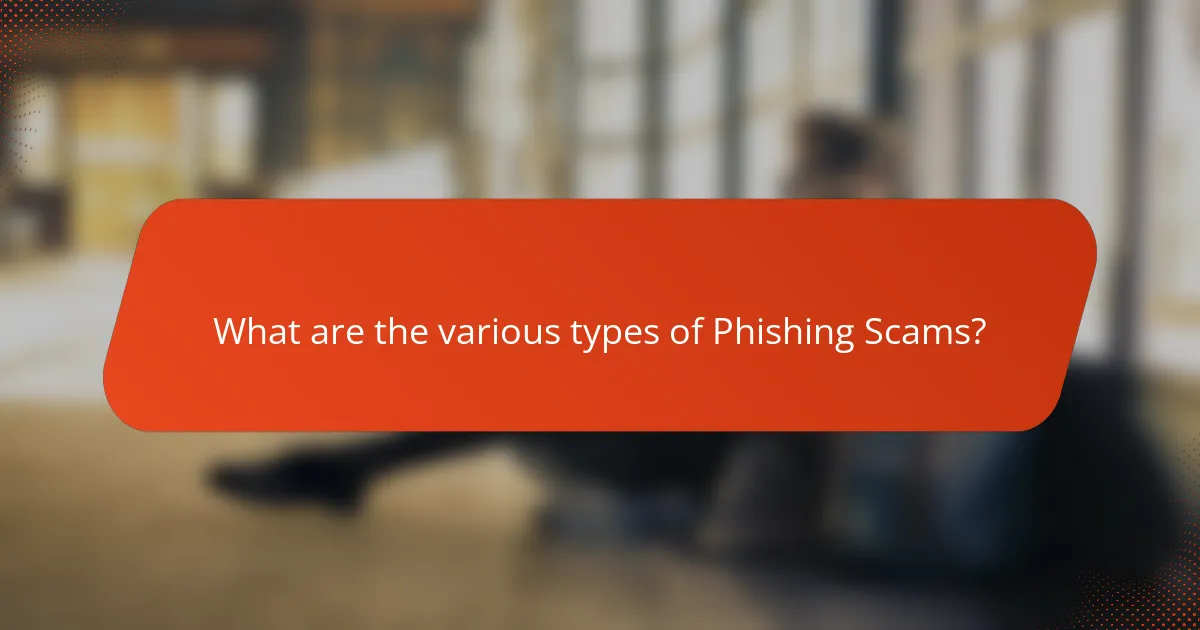
What are the various types of Phishing Scams?
Phishing scams can be categorized into several types. The most common type is email phishing. This involves fraudulent emails that appear to be from legitimate sources. Spear phishing targets specific individuals or organizations. It uses personal information to increase credibility. Whaling is a form of spear phishing aimed at high-profile targets, such as executives. Vishing involves voice calls to deceive victims into providing sensitive information. Smishing uses SMS text messages for similar purposes. Clone phishing duplicates a legitimate email and replaces its attachment with a malicious one. Lastly, angler phishing occurs on social media platforms, tricking users into revealing personal data. Each type employs different tactics but shares the goal of obtaining sensitive information.
What is Email Phishing?
Email phishing is a fraudulent attempt to obtain sensitive information via email. Attackers impersonate legitimate entities to deceive recipients. The goal is often to steal personal data, such as passwords or credit card numbers. Phishing emails frequently contain malicious links or attachments. They may appear to come from trusted sources, like banks or popular services. According to the Anti-Phishing Working Group, over 200,000 unique phishing attacks were reported in a single month in 2020. This highlights the prevalence and danger of email phishing.
How can one identify email phishing attempts?
One can identify email phishing attempts by examining several key characteristics. Phishing emails often contain generic greetings instead of personalized ones. They may include urgent calls to action, pressuring the recipient to act quickly. The sender’s email address may look similar to a legitimate one but often contains slight misspellings. Links within the email may lead to suspicious or unfamiliar websites. Phishing emails frequently contain poor grammar or spelling errors. They may request sensitive information, such as passwords or credit card numbers. According to the Anti-Phishing Working Group, over 70% of phishing emails use social engineering tactics to deceive users. Recognizing these signs can help individuals avoid falling victim to phishing scams.
What are common email phishing tactics?
Common email phishing tactics include impersonation, urgent requests, and malicious links. Impersonation involves attackers pretending to be a trusted entity. This can include using official logos or email addresses that closely resemble legitimate ones. Urgent requests create a sense of panic, prompting victims to act quickly without thinking. Malicious links often lead to fake websites designed to steal personal information. Other tactics include attachments containing malware and social engineering techniques that exploit human psychology. According to the Anti-Phishing Working Group, 74% of phishing emails contain malicious links.
What is Spear Phishing?
Spear phishing is a targeted form of phishing attack. It involves personalized emails sent to specific individuals or organizations. The attacker often researches their target to create a convincing message. This increases the likelihood that the recipient will engage with the email. Spear phishing aims to steal sensitive information, such as login credentials or financial data. According to the Anti-Phishing Working Group, spear phishing has become one of the most common tactics used by cybercriminals. It is particularly dangerous because it exploits trust and familiarity.
How does spear phishing differ from general phishing?
Spear phishing targets specific individuals or organizations, while general phishing casts a wider net. Spear phishing involves personalized messages that appear credible to the recipient. Attackers often use information gathered from social media or prior interactions. This makes the attack more convincing. In contrast, general phishing utilizes generic messages sent to many people. These messages often contain suspicious links or attachments. According to the Anti-Phishing Working Group, spear phishing is more effective due to its targeted nature. It results in higher success rates compared to general phishing attacks.
What are the risks associated with spear phishing?
Spear phishing poses significant risks, primarily targeting individuals or organizations for malicious intent. This type of phishing often leads to data breaches, resulting in unauthorized access to sensitive information. According to the Verizon Data Breach Investigations Report, 22% of data breaches involved phishing. Financial loss is another risk, as spear phishing can lead to fraudulent transactions. Furthermore, reputational damage can occur, affecting trust with clients and stakeholders. Lastly, spear phishing can facilitate further attacks, such as malware installation or ransomware. These risks highlight the need for robust cybersecurity measures.
What is Whaling?
Whaling is a type of phishing attack targeting high-profile individuals, such as executives or important figures within an organization. Attackers aim to steal sensitive information or gain unauthorized access to systems. These scams often involve personalized messages that appear legitimate, making them harder to detect. Whaling attacks can lead to significant financial loss and data breaches. Research shows that 91% of successful data breaches start with a phishing attack, highlighting the seriousness of whaling.
Who are the typical targets of whaling attacks?
The typical targets of whaling attacks are high-level executives and key decision-makers within organizations. These individuals often have access to sensitive information and financial resources. Attackers impersonate trusted sources to manipulate these targets into revealing confidential data. According to the FBI’s Internet Crime Complaint Center, businesses lose millions annually due to such attacks. The focus on high-ranking officials increases the likelihood of successful exploitation. Whaling attacks often leverage social engineering tactics tailored to the target’s role and responsibilities. This specificity makes them more convincing and dangerous.
What measures can be taken to prevent whaling attacks?
Implementing strong email authentication measures can prevent whaling attacks. These measures include using SPF, DKIM, and DMARC protocols. Training employees to recognize phishing attempts is also essential. Regular security awareness training can help staff identify suspicious emails. Employing advanced email filtering solutions can block malicious messages. Monitoring and analyzing email traffic can detect unusual patterns. Establishing a clear reporting process for suspected attacks is crucial. Regularly updating software and security protocols can mitigate vulnerabilities.
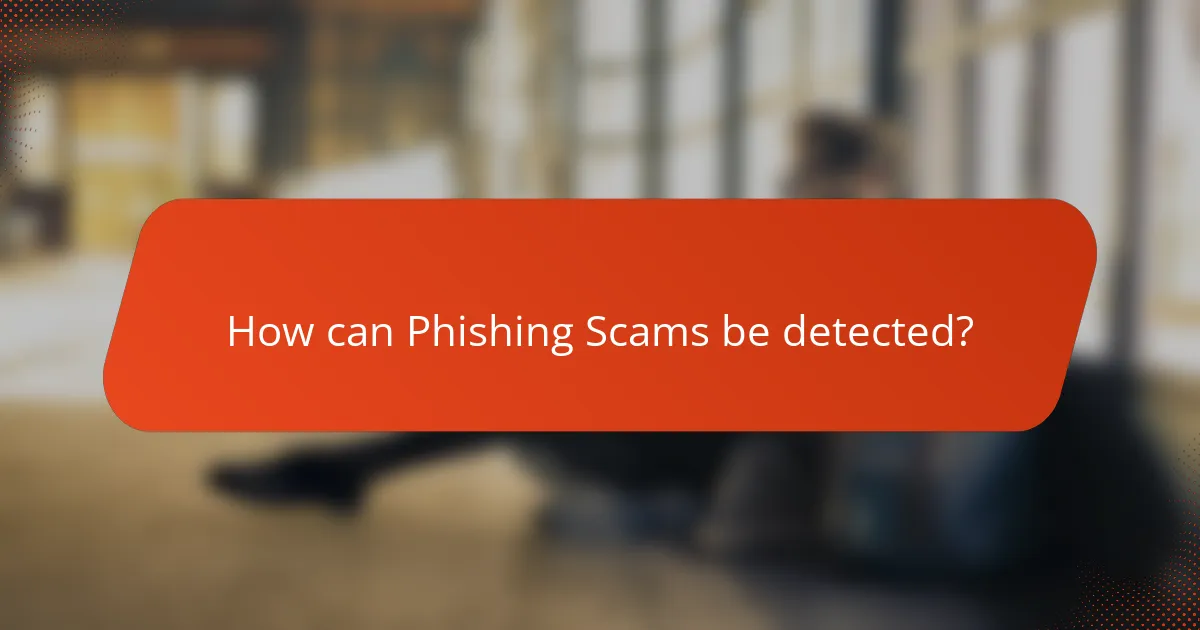
How can Phishing Scams be detected?
Phishing scams can be detected by analyzing suspicious emails and messages. Look for generic greetings that lack personalization. Check for spelling and grammatical errors, which are common in phishing attempts. Verify the sender’s email address to ensure it matches the official domain. Hover over links to see the actual URL before clicking. Be cautious of urgent language that pressures immediate action. Use security software that can identify and block phishing attempts. According to the Anti-Phishing Working Group, over 200,000 phishing sites were reported in 2020, highlighting the prevalence of these scams.
What tools can help in detecting phishing scams?
Tools that can help in detecting phishing scams include email filters, anti-phishing browser extensions, and security software. Email filters analyze incoming messages for suspicious links and known phishing patterns. Anti-phishing browser extensions alert users when they visit fraudulent websites. Security software often includes real-time protection that identifies and blocks phishing attempts. According to a report by the Anti-Phishing Working Group, these tools significantly reduce the risk of falling victim to scams. Regular updates to these tools enhance their effectiveness against evolving phishing tactics.
How do anti-phishing software and browser extensions work?
Anti-phishing software and browser extensions work by detecting and blocking phishing attempts. They analyze web pages in real-time to identify malicious content. These tools use lists of known phishing sites to compare against URLs. If a match is found, they alert the user or prevent access. Many employ machine learning algorithms to recognize suspicious patterns. They also scan emails for phishing links and warn users before they click. Regular updates to their databases enhance their effectiveness. Studies show that these tools significantly reduce the risk of falling victim to phishing attacks.
What role do email filters play in phishing detection?
Email filters play a crucial role in phishing detection by analyzing incoming messages for suspicious characteristics. These filters evaluate various attributes, such as sender reputation, email content, and embedded links. They use algorithms to identify common phishing tactics, including deceptive subject lines and misleading URLs. Studies show that effective email filters can block up to 99% of phishing attempts. This significantly reduces the risk of users falling victim to scams. Additionally, filters can adapt to new phishing techniques through machine learning. This ongoing learning process enhances their ability to recognize emerging threats.
What signs indicate a potential phishing attempt?
Signs that indicate a potential phishing attempt include unexpected emails requesting personal information. Phishing emails often contain generic greetings instead of personalized ones. They may include urgent language to create a sense of panic. Links in these emails often lead to suspicious or misspelled websites. Attachments may contain malware or harmful software. The sender’s email address may appear legitimate but often has slight variations. Poor grammar and spelling mistakes are common in phishing messages. Legitimate organizations typically do not ask for sensitive information via email.
How can users recognize suspicious links and attachments?
Users can recognize suspicious links and attachments by examining their characteristics carefully. They should look for misspellings or unusual domain names in links. Legitimate organizations typically use official domains. Users should also check for unexpected or unsolicited emails containing attachments. Attachments from unknown sources can harbor malware. Hovering over links without clicking can reveal the actual URL. If the link does not match the sender’s domain, it is likely suspicious. Additionally, users should be cautious of urgency in the message, which is a common tactic used in phishing. According to the Anti-Phishing Working Group, 75% of phishing emails contain links that redirect to malicious sites.
What are the common red flags in communication that suggest phishing?
Common red flags in communication that suggest phishing include unsolicited messages requesting personal information. Phishing attempts often use urgent language to create panic. They may contain poor spelling and grammar, which is uncharacteristic of legitimate organizations. Links in these messages often direct users to fake websites. The sender’s email address may look similar but not identical to a trusted source. Additionally, legitimate organizations typically do not ask for sensitive information via email. Recognizing these signs can help individuals avoid falling victim to phishing scams.
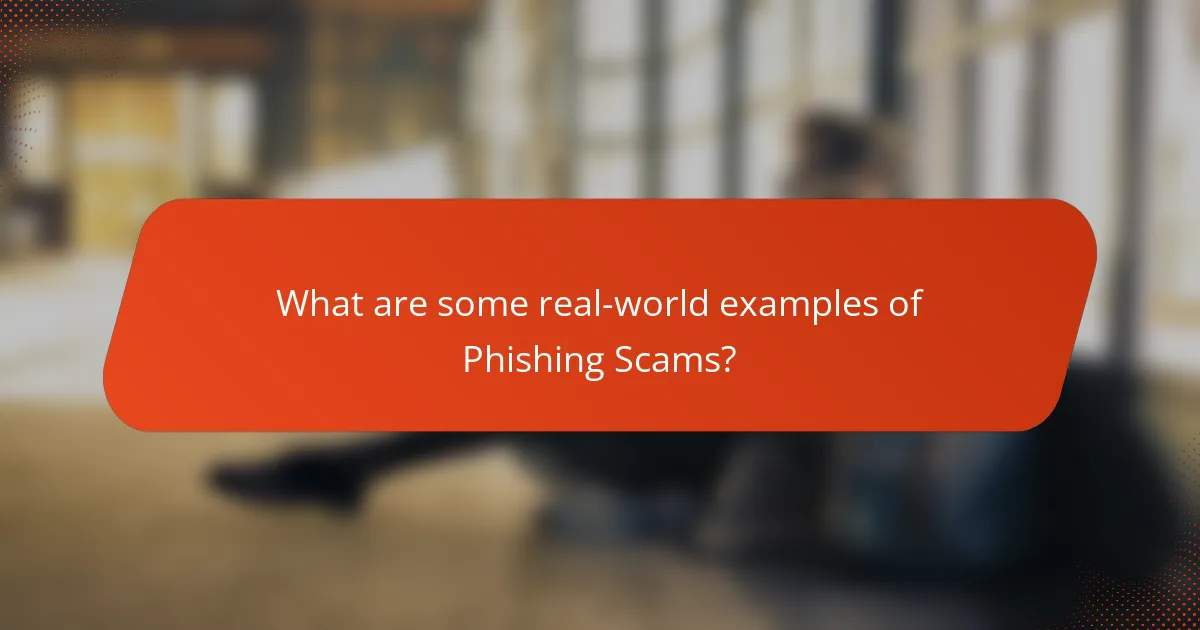
What are some real-world examples of Phishing Scams?
Some real-world examples of phishing scams include the 2016 Democratic National Committee email hack. Hackers posed as legitimate entities to steal sensitive information. Another example is the 2020 Twitter hack, where attackers gained access to high-profile accounts. This was done through social engineering tactics. A notable case involves Google and Facebook, which lost over $100 million to a phishing scam between 2013 and 2015. In this incident, the scammers impersonated a hardware supplier. Additionally, many individuals receive fake emails from banks asking for account verification. These emails often contain links to fraudulent websites. Phishing scams continue to evolve and target various organizations and individuals.
What notable phishing scams have occurred in recent years?
Notable phishing scams in recent years include the 2020 Twitter hack, where attackers accessed high-profile accounts. They used social engineering to trick employees into providing access. This led to a cryptocurrency scam that generated over $100,000 in Bitcoin. Another significant case was the 2021 Microsoft phishing attack. Cybercriminals impersonated Microsoft to steal personal information. They targeted users with fake emails claiming account issues. In 2022, the “Flubot” malware campaign spread via SMS phishing. It tricked users into downloading malicious apps, compromising their devices. These examples highlight the evolving tactics of phishing scams.
How did the Target data breach involve phishing?
The Target data breach involved phishing through an email attack that targeted a third-party vendor. Cybercriminals sent a fraudulent email to the vendor, which tricked employees into providing their login credentials. This compromised access allowed hackers to infiltrate Target’s network. Once inside, they installed malware on point-of-sale systems. The malware collected sensitive customer data, including credit card information. Ultimately, the breach affected approximately 40 million credit and debit card accounts. This incident highlights the dangers of phishing and the importance of securing third-party vendor access.
What lessons were learned from the phishing scam targeting Google and Facebook?
The phishing scam targeting Google and Facebook taught crucial lessons about cybersecurity vulnerabilities. Organizations must prioritize employee training on recognizing phishing attempts. The incident highlighted the importance of verifying requests for sensitive information, even from trusted sources. Multi-factor authentication can significantly reduce the risk of unauthorized access. Regular audits of financial transactions and vendor communications are essential for early detection of fraud. Implementing robust security measures can prevent similar scams in the future. The scam resulted in a loss of over $100 million, emphasizing the financial impact of such attacks.
What can individuals do to protect themselves from phishing scams?
Individuals can protect themselves from phishing scams by being cautious with emails and messages. They should verify the sender’s email address before clicking on links. Hovering over links to see the actual URL is essential. Using two-factor authentication adds an extra layer of security. Regularly updating passwords can prevent unauthorized access. Installing antivirus software helps detect malicious attempts. Educating themselves about common phishing tactics is crucial. According to the Anti-Phishing Working Group, over 200,000 phishing sites were reported in a single month, highlighting the ongoing threat.
What best practices should users follow to avoid falling victim to phishing?
Users should follow several best practices to avoid falling victim to phishing. First, they should verify the sender’s email address before clicking any links or downloading attachments. Phishing emails often use addresses that mimic legitimate ones. Second, users should avoid sharing personal information through email or unfamiliar websites. Legitimate organizations typically do not request sensitive information this way. Third, they should look for signs of phishing, such as poor grammar or urgent requests. These are common indicators of fraudulent messages. Fourth, users should enable two-factor authentication on their accounts. This adds an extra layer of security even if credentials are compromised. Fifth, they should keep software and antivirus programs updated. Regular updates can protect against known vulnerabilities. Finally, users should report suspicious emails to their email provider. This helps improve security for everyone. Following these practices significantly reduces the risk of falling victim to phishing attacks.
How can awareness and education help in combating phishing scams?
Awareness and education are crucial in combating phishing scams. They empower individuals to recognize and avoid potential threats. Educated users are more likely to identify suspicious emails and links. For instance, training programs can increase awareness of common phishing tactics, such as urgency or impersonation. According to a study by the Anti-Phishing Working Group, organizations with regular training reduce phishing susceptibility by up to 70%. Awareness initiatives also promote reporting of phishing attempts. This collective vigilance helps organizations respond more effectively. Ultimately, informed individuals create a safer online environment.
Phishing scams are fraudulent attempts to obtain sensitive information from individuals through deceptive emails, messages, or websites that mimic legitimate entities. This article explores the various techniques employed by scammers, including email phishing, spear phishing, and whaling, while highlighting the significant risks and financial losses associated with these attacks. It also details methods for detecting phishing attempts, such as recognizing suspicious links and using security tools, and provides real-world examples of notable phishing incidents. Understanding these aspects is crucial for individuals and organizations to effectively combat phishing threats and protect sensitive information.
